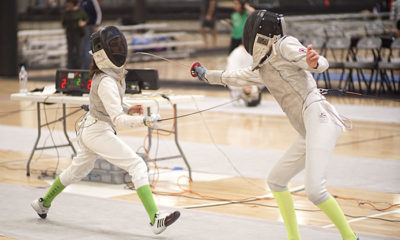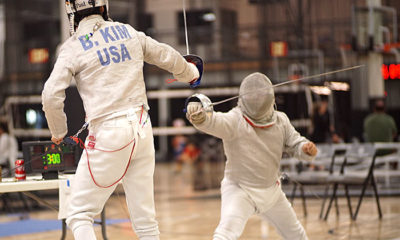
Daniel Oganesian (Swords, left) discusses strategy with Thien Scofield (Allez) at the 2017 Musketeers Region Youth Circuit in Northridge, Calif.
Fencing Competitions – Recommendations for Beginning Fencers and Parents
Once your child starts competing, everything changes. In a great way. Your child is going to start to put into action the things he or she has worked on in classes and during private lessons. Your child will gain self-confidence, make new friends, and have some fun.
Below are some suggestions to help make the experience a successful one, regardless of how your child does in the tournament. This is the second part of a series meant to help guide new fencers and families through the tournament experience. Later posts will explore how a tournament works (seeding, pools, DE’s), travel tips, etc.
Getting There
Being prepared helps you get out of the door and on the freeway (for some reason the tournament location always involves a freeway in California!) and helps your child focus on fencing. Typically, the calmer the parent is, the calmer the child is. Planning ahead by figuring out the route to take to the tournament and getting all of the equipment together in advance is a great way to avoid chaos in the morning, especially as events often start early.
Here is a list of what you need for a competition:
Required Equipment
(Put your name on everything! Not just your initials, as someone else might have the same initials)
Mask
Swords – Two are required – at least three is recommended. Your child could be disqualified if he or she does not have a working weapon. Also, Y10 fencers use a shorter blade. If your child is fencing in a Y10 event and a Y12 event, you should have at least four swords, two shorter, two longer.
Underarm Protector
Chest Protector (mandatory for girls of all ages and for boys in Y10 and Y12.
Fencing Pants
Fencing Jacket – Two notes on the fencing jacket:
It is a good idea to invest in a club patch that should be sewn onto the non-fencing arm of the fencing jacket. This patch not only shows club pride, but, more importantly, helps coaches find their fencers in a sea of white uniforms in the larger tournaments. Coaches are often running between strips helping their students, and easily spotting that patch can make a big difference.
The last name on the back is required at national competitions only. (Note – There is always a vendor at national events who is able to put the name on the back. Be sure and do this before the event. It can take a while if there is a line. If you are going to your first national competition, get the name put on the jacket the day before, when you do your equipment check. Do not just write the name on the back in pen. This can, depending on the referee, lead to a red card each and every time your fencer gets on the strip to fence.)
Lamé (foil and saber, only)
Fencing Socks (knee socks – you don’t have to have fencing socks, but you must have long socks. They don’t have to be white.)
Two Body Cords
Two Mask Cords (foil and saber, only)
Recommendations
Change of Clothes – A tournament can last all day, and there is typically at least 45 minutes to a few hours if pools are flighted (more on that in a later blog) between pools and the direct elimination portion of the tournament. Mary Huang, a veteran fencer, suggests that you “bring a couple of extra tee shirts and for girls, extra sports bras to change into after pools and before each DE. Taking a few minutes to change out of a wet shirt and rinse your face is a great way to mentally and physically refresh and reset.”
Club Warm Up Jacket – Most fencing clubs have club jackets with the club logo. This jacket is a great investment in a number of ways. It builds team or club morale, can be worn over the fencing jacket to keep your fencer’s muscles warm, and helps coaches and referees more easily spot fencers. If your fencer ends the day by standing on the podium, the club jacket should be worn.
Food and Water – Parents have all kind of helpful recommendations for what food and drink is best for their fencers. The first rule, really, is to bring something you know your fencer will eat. Every child is different – some want a big breakfast, some are too nervous to eat, some want to eat throughout the day, some seem to be able to eat nothing but air until the fencing is over. You will have to figure out what works best with your child. And it changes as children grow and get older. Some good recommendations are: bananas, m&m’s for a little added energy when fencing a long day (that sugar boost right before a bout late in the tournament can be a real help), pretzels, Cliff bars. Mary Huang, a veteran fencer, recommends PB&J sandwiches which “provide quick energy, the bread is a longer energy source, and the peanut butter provides staying power Easy to make and pack.” It is best to stay away from something big between the pools and the direct eliminations, as that can sometimes cause stomach cramps. But it is important to keep your fencer’s energy up, so have options available. Also, it can’t be overemphasized the importance of keeping your fencer hydrated. A leading cause of cramping and headaches is lack of hydration. We suggest water and Gatorade or Vitamin Water. You can almost always purchase drinks and bananas and some sort of snack at the venue, but not always, so don’t count on that.
A Small Cooler – Helpful for keeping drinks and snacks cool and in one place.
A Towel. Pretty self-explanatory (hand towel, not a bath towel).
A Chair. One of those fold-out camping stools or chairs. There are not always a lot of places to sit. You might want one for yourself as well. Believe it or not there is a lot of waiting around at a tournament.
The Night Before
Pack everything your fencer needs ahead of time, so there is no last minute panic.
Make sure your fencer gets a good night’s sleep.
Competition Day
Plan to arrive at least an hour before the close of check in for your fencer’s event.
Check In – Parents – have your fencer check him or herself in at the check in desk upon arrival. Do not do it for them. This will help give them a sense of independence, and start a habit that will last for hopefully, several years. The items that will be needed to check in are:
- US Fencing Card – on your phone or printed out. You can log in to USA Fencing, and take a screenshot of the membership card. It has a bar code which can be scanned.
- Proof of Age – birth certificate copy if you have not yet gotten your child’s age verified through US Fencing.
Equipment Check – Immediately after checking in, your fencer should take his or her equipment to the Equipment Check. You can ask where that is located at check-in. The items that need to be checked are:
- Mask
- Glove
- Two body cords
- Two mask cords (foil and saber, only)
- Lamé (foil and saber, only)
Equipment Check is for your fencer’s safety. The armorer is looking for holes in gloves, masks that might be damaged or cracked in some way, and body cords, to make sure that they are functioning correctly. Weapons are checked on the strip at the beginning of each bout.
Warm Up – After Weapons Check, your fencer needs to get dressed and then start to warm up. Fencers should stretch out and then a light jog around the venue is a good way to start. Jumping jacks are also good, and some fencers bring a jump rope to warm up with.
Fencers should also try to fence at least two warm up bouts with other fencers. Encourage them to look for someone they don’t know to fence. They fence the same people at the club all the time. This is a great chance to fence someone new.
Once check-in is closed, Pools will be announced. This posting might be online but should also be posted somewhere in the venue. Your child should find out which strip he or she will be fencing on, and proceed to that strip will all of the equipment (that has been checked at Weapons Check) and swords, and be ready to start fencing.
Good luck!
The next blog will detail the structure of tournaments – seeding, pools, and the direct eliminations.















Fencing Dad
2018-03-04 at 8:57 AM
These are great recommendations and highlights of how a young fencer (and parents) should get ready for a tournament. In the beginning, my wife and I performed all these checks ourselves (rather than having my beginning fencer do them), but gradually, we have been transitioning many of the preparedness/responsibilities to our child. Great training to get ready for life! One add — which not everyone does, but we recommend: test the weapons before the tournament with a testing kit (weight/shim/cords) and eyeballs (tips/wires/loose parts) to make sure they will pass. Kids and parents get rattled if the first thing that happens is the fencer getting a yellow card because of weapon defect and you frantically search for a working weapon from friends/vendor.
Kathryn
2018-03-05 at 12:40 PM
Thanks so much for your feedback. You are absolutely right recommending checking the weapons beforehand. Those testing kits are a great investment. Even if you don’t have weights and shims at home, fencers can find a free reel at the tournament and hook up their weapons to make sure they are working before pools begin. And also checking those screws before each bout in pools. The next article in this series goes into much more detail about the actual tournament, and includes checking your weapons, but it would have maybe been better here. Thanks again!